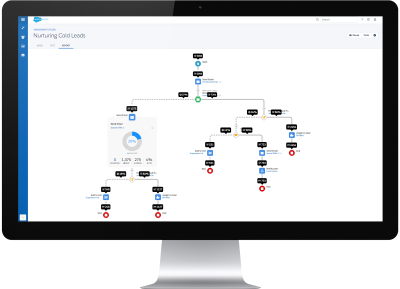


How marketing automation transforms cold calling
10 August, 2015
Cold calling is especially tough with complex sales for a few reasons:
- You have to get lucky - calling a prospect who actually cares about the problem you're trying to solve at the moment you've contacted them.
- You have to educate them - around who you are, the problem they have and how you're uniquely positioned to help them solve it.
- You have limited time to connect - they didn't ask for the call, and understanding your complex proposition probably isn't on their list of priorities that day.
Here's the current cold calling approach for complex sales:
Let's use a recruitment company as an example.
- The recruitment agent hits the phone trying to pitch their services to time-poor hiring managers and company directors.
- If the prospect happens to be hiring at that moment, doesn't have an existing recruitment agent but would consider using one, they may get a meeting.
- If not, it's "when can I follow up" and the prospect periodically receives a "how about now" call for the foreseeable future.
Here's how cold calling works when leveraged with marketing automation:
Step 1: Get permission
When the rep gets a "no" to the initial meeting request, they retreat to "can I send you some information on who we are and what we do should you need us in the future?" Not wanting to appear dismissive, the prospect will grant this request more often than not. The rep now has a name, job role, industry vertical, email address and most importantly, permission to send marketing communications.
Step 2: Nurture
From within their CRM, the rep then adds the prospect to a "lead nurturing drip" campaign. Over 12 months, the prospect will go on a relevant, targeted communication schedule mixing personal one-to-one emails with tailored marketing content. This could look something like:
Post call: personal thank you for your time email with company profile attached
1 month: case study of recent project done for company in their vertical
3 month: vertical-specific profiles on candidates looking for work in their field etc.
Step 3: Get insight
Here's what happens in the background:
- As soon as the prospect clicks on a link in the automated email, their computer is cookied and matched with their profile in the CRM.
- Every time the prospect takes any engagement action (email open or click, website page view, file download, social media share etc) their engagement is recorded, scored and is viewable in the CRM.
- Real time alerts are fired to the rep as prospects start engaging with the content.
Step 4: Re Engage at the right time
When the prospect has demonstrated engagement the rep knows it's time to pick up the phone and reconnect with the prospect! "Send me some information" is just the start of a nurturing journey with that prospect.
Let's say that 6 months after the initial sales call, the prospect is now hiring. The prospect receives an automated and timely email on current industry salary statistics, clicks through and visits 5 pages on the website. An alert is sent through to the rep and they then "just happen" to call to see what the prospects hiring needs are in the coming months. It's now a lot easier to book that meeting.
A final thought - don't be creepy
Reps need to be taught how to act on the insights that marketing automation provides. Being relevant and helpful is great. "I saw you visited 5 pages on our website this morning" feels like someone's hiding in the bushes outside the office.
Related articles
Using Marketing Automation Across the B2B Customer Journey
05 February, 2016
There's a tendency to think the only use case for marketing automation is at the front of the sales funnel. In reality, marketing automation can become the glue that ties the entire customer journey together. From lead generation and nurturing, through to re-engagement, solution selection, customer onboarding, and proactive account service. Let's take high level look at how marketing automation can enhance the customer experience and drive revenue throughout the customer lifecycle:
MorePlanning your Pardot implementation
14 July, 2016
Beginning the journey towards implementing marketing automation technology is exciting and, as with all things new, contains a few unknowns. Here at LavaBox we've been around the Pardot block a few times and have some useful suggestions to help you plan for your implementation.
More5 Lead nurturing campaigns to convert your prospects into contracts
01 September, 2016
Lead nurturing empowers marketers to craft tailored content journeys that take prospects down different routes based on their actions (like clicking through on email links) or data profile in Salesforce (like their lead score or industry vertical). These campaigns deliver content that supports the sales process and influence prospects throughout the customer journey. Below are five lead nurturing campaigns that help move prospects from "new lead" through to "contract signed."
MoreLevel 2 - 224 Symonds St
Eden Terrace
Auckland 1024







